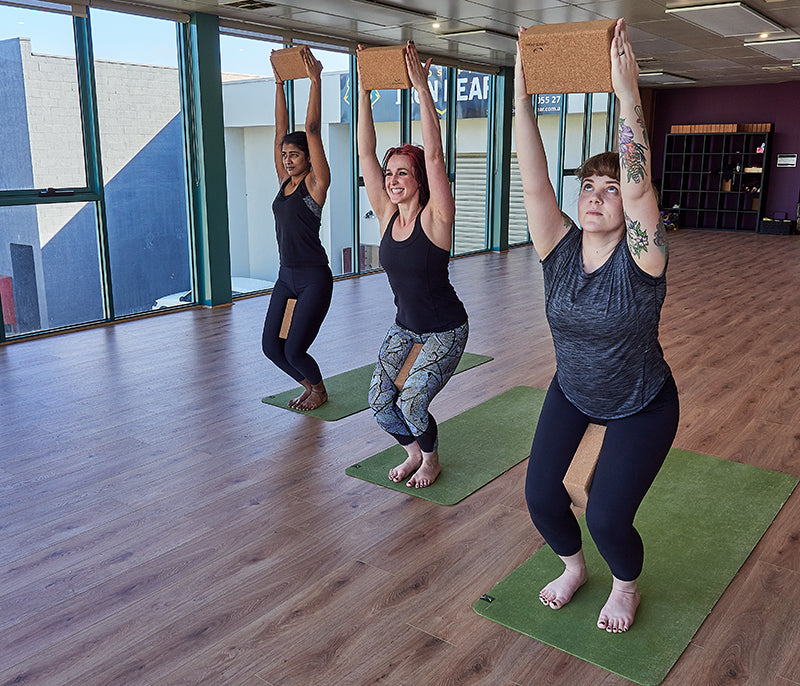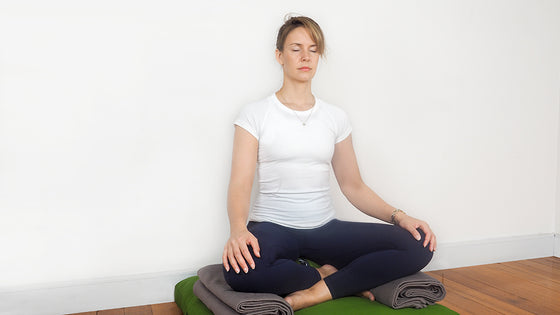- Ergonomic Products
- Ergonomic Furniture
- Yoga
- Meditation
- Pilates
- Air Treatment
- Blog
- Resources
- About Us
- Wholesale
- Ergonomic Products ▼
- Ergonomic Furniture ▼
- Yoga ▼
- Meditation ▼
- Pilates ▼
- Air Treatment ▼
- Blog
- Resources ▼
- About Us
- Wholesale
- Sign in
Which humble yoga prop offers more lift than a home-renovators favourite TV show and helps you reach further and get stronger?
Yes, it’s the block! The stout and unassuming yoga block may not be the softest or curviest member of the yoga-prop family, but it can help your practice in dozens of ways.
About the same size as a short stack of your favourite paperbacks, the versatile block can be used on 3 elevations to suit your requirements and in a variety of yoga poses.
When using a yoga block, adopt a curious attitude and experiment with the different heights available. Choose the elevation that feels ‘just right’ for your body. On that note, let’s refer to the lowest elevation as ‘Baby Bear’, the middle; ‘Mama Bear’, and the highest; ‘Papa Bear’.
Here’s what the yoga block can help you achieve in your practice.
Connection, length and alignment
In standing poses such as Trikonasana and Parsvakonasana, a block allows the lower hand to connect to the ground, even if it can’t quite reach. Using the block as a steady landing pad helps minimise any straining or overstretching in an effort to touch the floor, and encourages integrity with alignment and function of the pose.
Parsvakonasana

Setting up: For both of these poses, place the block beside the foot on the little-toe side of your leading leg. Use the elevation of the block which best allows you to maintain length along both sides of the torso. Keep your touch on the block light. Stay for 5 deep breaths, then switch sides.
Strengthen and engage
For Utkatasana, use a block to help strengthen and engage the arm and leg muscles.
Utkatasana

Setting up: Place one block lengthways between the thighs and a grip a second block between the palms. Keeping the soles of the feet grounded and the jawline relaxed, gently squeeze both blocks. Squeezing the block with your palms activates external rotation of the arms. By squeezing the block between the thighs, you’ll activate on and firm the inner lines of the legs.
Lift, open and hold
You’ll have to try it to believe it, but solid cork, bamboo or balsa wood blocks are surprisingly comfortable to rest on! In these 2 passive backbends, the blocks invite a gentle blossoming and elevation at the heart centre, while simultaneously holding us so securely that it is actually possible to surrender.
Supported Setu Bandha Sarvangasana (bridge) pose

Setting up: Rest down on your mat with the legs bent, feet flat, about hip-distance apart. Have your block beside you, on ‘Baby Bear’ elevation. Lift the hips up away from the mat as you breathe in. Now, slide the block underneath, and lower down landing the sacrum on the block. Make any adjustments so you are comfortable. After a minute or two, decide if you’d like a little more. If yes, lift up and flip the block to ‘Mama Bear’ height, settling back into a mid-level backbend. Check in with how you feel. If it feels right, continue deepening the backbend by progressing to ‘Papa Bear’ elevation.
Stay at each elevation a few minutes, then progress back down to the mat in the same slow and methodical fashion.
Supported Matsyasana fish pose.

Setting up: Place a ‘Mama Bear’ block at the top of your mat - this will be for the back of your head. Arrange a ‘Baby Bear’ about a third of the way down the mat - you’ll rest your upper back here.
Sit on the mat with the legs outstretched. Slowly descend so the lower block sits under your ‘bra-line’ (Guys, you get it, right?) and place your head on ‘Mama Bear’. Rest the arms and hands comfortably on the mat, soften the legs.
Rest, soften and release.
The following 2 restorative yoga poses invite deep surrender and rest. Here, the blocks help to hold you in nurturing poses and close the gap between body and floor.
Supta badha konasana

Setting up: Place one or two blocks under the top end of your bolster, creating a ramp. Sit with your back against the low end of the bolster, and bring the soles of the feet together so the knees fan apart. Wedge a block under each thigh to hold the legs in place and invite the hips to soften. Carefully lower the back to rest along the length of the bolster. Find a comfy position for the arms, relax the head and settle in for a few minutes.
Stonehenge

When the legs, (and calf muscles in particular) need some pampering, try stonehenge pose. Use the blocks here to hold a bolster in place for the legs to rest on. This pose serves up the soothing, refreshing benefits of a mild inversion, plus by sinking into the squishy bolster, the calf muscles receive a welcome treat.
Setting up: Place 2 blocks in ‘Mama Bear’ elevation, hip-width apart, toward the end of your mat. Getting into this pose is similar to launching into legs up the wall. Sit side-on to your Stonehenge structure, then, as you lay the back on the mat, swing the lower legs up to rest hip-width apart on the bolster.
Ready to play blocks? Check out our range, made from natural sustainable materials like balsa, bamboo or cork. Or for something different, check out the new kid on the er..block - our ‘All-in-one’ cotton block serves as a traditional yoga block as well as a mini-bolster and zafu!


